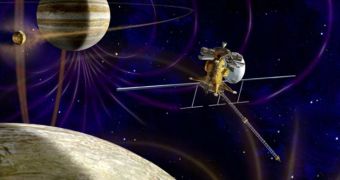The Europa Jupiter System Mission is a proposed collaboration of NASA and the European Space Agency (ESA), that will see a spacecraft, or several probes, being sent to analyze the gas giant and its moon and ring systems. Experts from the two agencies met recently to discuss their vision on the flight.
At the meeting, they also asked for and accepted science input from colleagues around the world. What experts want to do is put a spacecraft in Jovian orbit that would be able to conduct the same type of studies as the Cassini orbiter around Saturn.
Analyzing the gas giants of our solar system is an endeavor that could yield more details about how the solar system evolved, and about the factors that keep those planets and their moon in their current configuration. Plus, a long-term mission to Jupiter has been a long time coming.
Following the recent talks, experts from the two space agencies announced their common vision on the new mission, which is to explore “the emergence of habitable worlds around gas giants.”
If approved by relevant authorities, the EJSM will include two orbiters. One of them will fly around the icy moon Europa, and will be called the Jupiter Europa Orbiter (JEO). The other one will orbit Ganymede, and will be called the Jupiter Ganymede Orbiter (JGO).
According to the announcement made after the conference, JEO will be provided by NASA, whereas ESA will be in charge of constructing, launching and operating JGO, Daily Galaxy reports.
“We've reached hands across the Atlantic to define a mission to Jupiter's water worlds,” JEO pre-project scientist Bob Pappalardo says. He is based at the NASA Jet Propulsion Laboratory (JPL), in Pasadena, California.
“The Europa Jupiter System Mission will create a leap in scientific knowledge about the moons of Jupiter and their potential to harbor life,” the expert goes on to say, adding that the two agencies have been working separately for quite some time.
The unified approach they are now taking is meant to underline yet again the fact that space exploration is moving from an area where it is being conducted by a single space agency to a place where several national actors join forces to reach a difficult objective.
“The real key to life on Europa is the permeability of the ice crust. There is strong evidence that the ocean below the ice is connected to the surface through cracks and melting, at various times and places,” explains Richard Greenberg, a professor of planetary sciences at the University of Arizona.
“As a result, the , if there is one, includes not just the liquid water ocean, but it extends through the ice up to the surface where there is access to oxidants, organic compounds, and light for photosynthesis,” he goes on to say.
“The physical setting provides a variety of potentially habitable and evolving niches. If there is life there, it would not necessarily be restricted to microorganisms,” the expert concludes.

 14 DAY TRIAL //
14 DAY TRIAL //